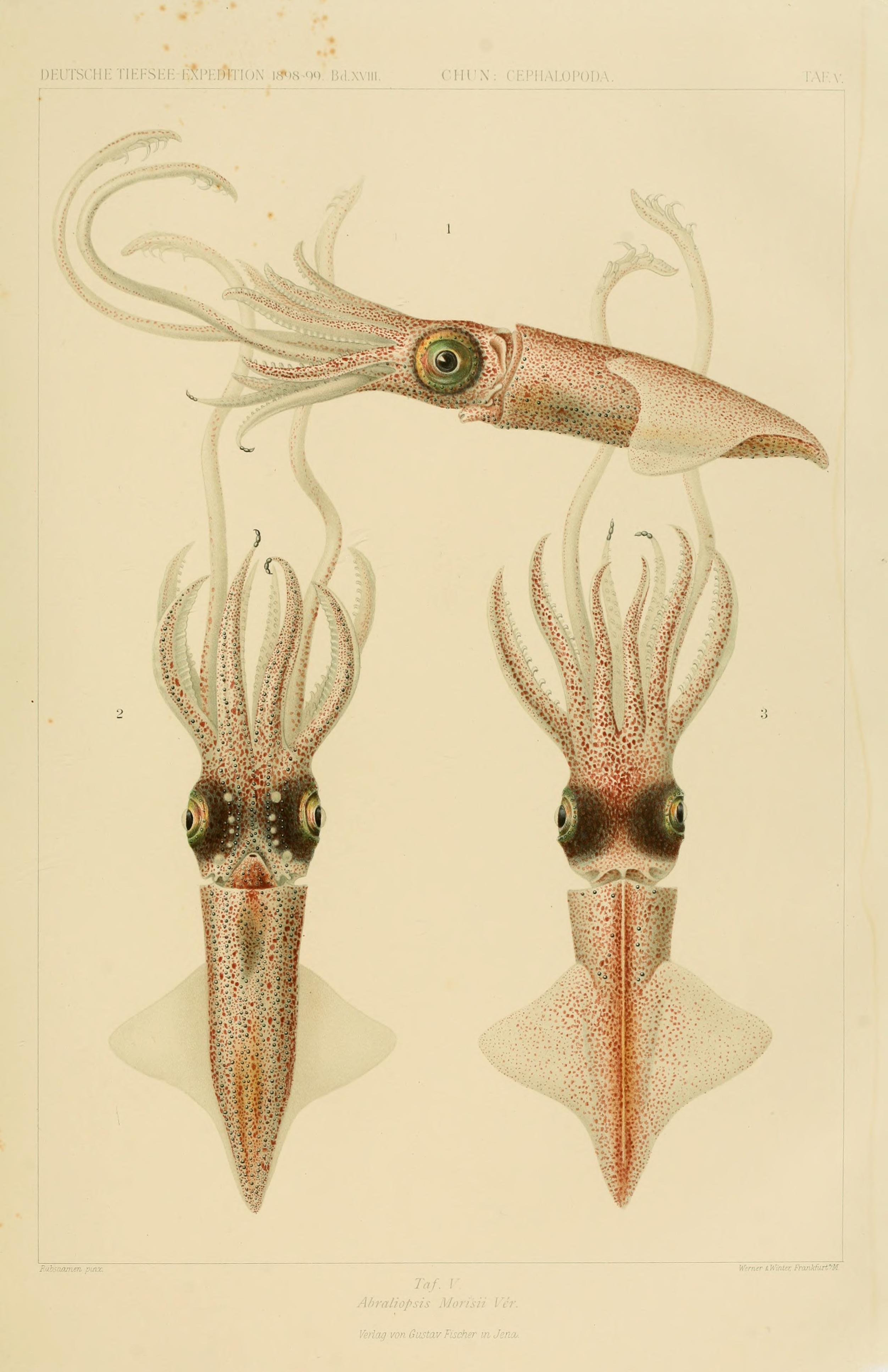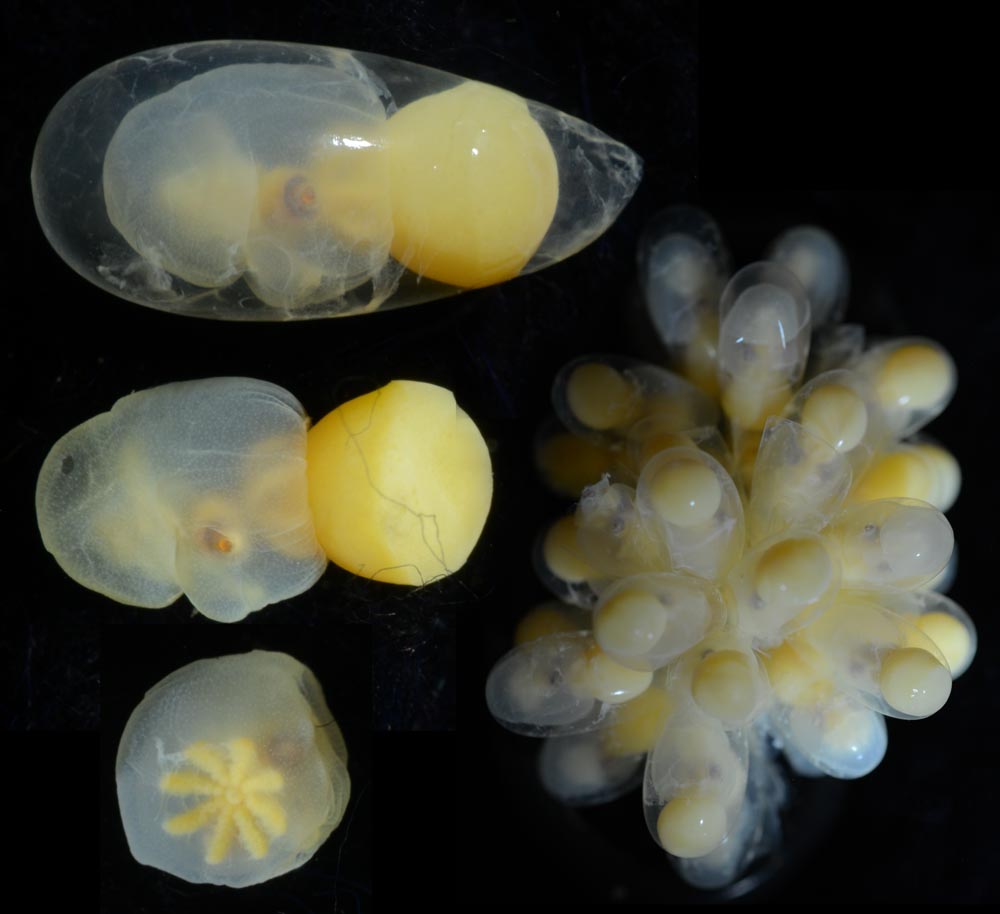|
Hectocotylised
A hectocotylus (: hectocotyli) is one of the cephalopod limb, arms of male cephalopods that is specialized to store and transfer spermatophores to the female. Structurally, hectocotyli are muscular hydrostats. Depending on the species, the male may use it merely as a conduit to the female, analogously to a penis in other animals, or he may Autotomy, wrench it off and present it to the female. The hectocotyl arm was first described in Aristotle's biology, Aristotle's biological works. Although Aristotle knew of its use in mating, he was doubtful that a tentacle could deliver sperm. The name ''hectocotylus'' was devised by Georges Cuvier, who first found one embedded in the mantle of a female Argonaut (animal), argonaut. Thinking it to be a helminths, parasitic worm, in 1829 Cuvier gave it a name of a biological genus, generic name (''Hectocotyle''), which is a New Latin term combining the Greek words for "hundred" (''hec(a)to(n)'') and for "hollow thing, cup" (''cotyle''). Structu ... [...More Info...] [...Related Items...] OR: [Wikipedia] [Google] [Baidu] |
Coleoidea
Coleoidea or Dibranchiata is one of the two subclasses of cephalopod molluscs containing all the various taxa popularly thought of as "soft-bodied" or "shell-less" (i.e. octopus, squid and cuttlefish). Unlike its extant sister group Nautiloidea, whose members have a rigid outer shell for protection, the coleoids have at most an internal shell called cuttlebone or gladius that is used for buoyancy or as muscle anchorage. Some species, notably incirrate octopuses, have lost their internal shell altogether, while in some it has been replaced by a chitinous support structure. The major divisions of Coleoidea are based upon the number of arms or tentacles and their structure. The extinct and most primitive form, the Belemnoidea, presumably had ten equally-sized arms in five pairs numbered dorsal to ventral as I, II, III, IV and V. More modern species either modified or lost a pair of arms. The superorder Decapodiformes has arm pair IV modified into long tentacles w ... [...More Info...] [...Related Items...] OR: [Wikipedia] [Google] [Baidu] |
Argonautidae
The Argonautidae are a family of pelagic cephalopods that inhabit tropical and temperate oceans of the world. The family encompasses the modern paper nautiluses of the genus '' Argonauta'' along with several extinct genera of shelled octopods. Though argonauts are derived from benthic octopuses, they have evolved to depart the sea floor and live their life-cycle in the open seas. The family is characterised by brittle white shells constructed by the females, but which the dwarf male argonauts lack. These shells are primarily egg-cases, and are not attached to the body of the female. Paper nautiluses are often found washed up on beaches and are valued for their delicate beauty. The shell also plays the role of a buoyancy device, which the female controls by varying the amount of gulped air.Finn, Julian K., and Mark D. Norman. "The Argonaut Shell: Gas-mediated Buoyancy Control in a Pelagic Octopus." Proceedings: Biological Sciences 277, no. 1696 (2010): 2967-971. Accessed Marc ... [...More Info...] [...Related Items...] OR: [Wikipedia] [Google] [Baidu] |
Argonauta Bottgeri
''Argonauta bottgeri'', also known as Böttger's argonaut, is a species of pelagic octopus belonging to the genus '' Argonauta''. The female of the species, like all argonauts, creates a paper-thin eggcase that coils around the octopus much like the way a nautilus lives in its shell (hence the name paper nautilus). ''A. bottgeri'' is the smallest argonaut species. The eggcase rarely exceeds 50 mm in diameter, although exceptional specimens have been known to grow up to 67.0 mm. ''A. bottgeri'' is similar to '' Argonauta hians'', but differs in having more pronounced ribs and prominent tubercles on the keel. The eggcase does not have winged protrusions as is sometimes the case with ''A. hians''. It is generally darker than that of any other species, ranging in colour from ochre-yellow to almost black, although completely white specimens have been reported from South African waters. The eggcase is finely granulated and normally lacks the porcelain-like shine of other ... [...More Info...] [...Related Items...] OR: [Wikipedia] [Google] [Baidu] |
Argonauta Bottgeri Hectocotylus-2
Argonauta may refer to: Animals * Argonaut (animal), molluscs of the genus ''Argonauta'' *'' Aprominta argonauta'', a species of moth *'' Asterias argonauta'', a species of starfish *'' Dentimargo argonauta'', a species of sea snail *''Dorcadion sulcipenne argonauta'', a subspecies of the beetle species '' Dorcadion sulcipenne'' Ships *, a class of submarines of the Italian Navy * , two submarines of the Italian Navy * , various ships of the Spanish Navy See also * Argonaut (other) * Argonaute * {{disambig ... [...More Info...] [...Related Items...] OR: [Wikipedia] [Google] [Baidu] |
Enoploteuthidae
Enoploteuthidae is a family of squid comprising approximately 40 species in four genera. Most species have a mantle length ranging from . Hooks are present on all arms and tentacles. The family is best known for the large array of photophores throughout the body. Species *Genus '' Abralia'' **'' Abralia andamanica'' **'' Abralia armata'' **'' Abralia astrolineata'' **'' Abralia astrosticta'' **'' Abralia dubia'' **'' Abralia fasciolata'' **'' Abralia grimpei'' **'' Abralia heminuchalis'' **'' Abralia marisarabica'' **'' Abralia multihamata'' **'' Abralia omiae'' **'' Abralia redfieldi'' **'' Abralia renschi'' **'' Abralia robsoni'' **'' Abralia siedleckyi'' **'' Abralia similis'' **'' Abralia spaercki'' **'' Abralia steindachneri'' **'' Abralia trigonura'' **'' Abralia veranyi'', eye-flash squid or Verany's enope squid *Genus '' Abraliopsis'' **'' Abraliopsis affinis'' **'' Abraliopsis atlantica'' **'' Abraliopsis chuni'' **'' Abraliopsis falco'' **'' Abraliopsis felis'' ... [...More Info...] [...Related Items...] OR: [Wikipedia] [Google] [Baidu] |
Abraliopsis Morisi
''Abraliopsis morisii'' is a species of bioluminescent squid in the family Enoploteuthidae. The species occurs in tropical to warm temperate In geography, the temperate climates of Earth occur in the middle latitudes (approximately 23.5° to 66.5° N/S of the Equator), which span between the tropics and the polar regions of Earth. These zones generally have wider temperature ran ... waters in the Atlantic Ocean, including the Gulf of Mexico and the Mediterranean Sea. It can be found in the epipelagic and mesopelagic zones. Jean Baptiste Vérany described the species in 1839 and it reaches lengths of . It is rated as least concern by the International Union for Conservation of Nature (IUCN). Description Male specimens of ''A. morisii'' mature in between 120 and 130 days, and females mature in between 150 and 160 days; although, a mature female has been observed at 127 days and a mature male at 105 days. It occurs in the Atlantic Ocean, Mediterranean Sea, and the ... [...More Info...] [...Related Items...] OR: [Wikipedia] [Google] [Baidu] |
Abraliopsis Morisi Hectocotylus-English
''Abraliopsis'' is a marine genus of squid (family Enoploteuthidae) of the phylum Mollusca. Not much is known about ''Abraliopsis'' due to the evading ability of pelagic cephalopods. Features that distinguish these species include the absence of arm suckers, size and number of hooks on arms, the presence of photophores, and the formation and position of chromatophores. 11 species that make up the Enoploteuthidae family. Species The following species are listed as members of the genus ''Abraliopsis'': *Subgenus ''Abraliopsis'' Joubin, 1896 **'' Abraliopsis hoylei'' (Pfeffer, 1884) **'' Abraliopsis morisii'' ( Vérany, 1839), Pfeffer's enope squid **'' Abraliopsis pacificus '' Tsuchiya & Okutani, 1990 **'' Abraliopsis tui'' Riddell, 1985 *Subgenus ''Boreabraliopsis'' Tsuchiya & Okutani, 1988 **'' Abraliopsis felis'' McGowan & Okutani, 1968 *Subgenus ''Micrabralia'' Pfeffer, 1900 **'' Abraliopsis gilchristi'' Robson, 1924 **'' Abraliopsis lineata'' Goodrich, 1896 *Subgenus ' ... [...More Info...] [...Related Items...] OR: [Wikipedia] [Google] [Baidu] |
Funnel–mantle Locking Apparatus
The funnel–mantle locking apparatus is a structure found in many cephalopods that connects the mantle and hyponome (funnel) and restricts their movement relative to each other.Young, R.E., M. Vecchione & K.M. Mangold (1999)Cephalopoda Glossary Tree of Life Web Project. It consists of two interlocking components: one located on the mantle (often fibrous) and the other on the funnel (often cartilaginous). The apparatus may permit some anterior–posterior displacement or prevent movement altogether. Function Variability Funnel component Six major forms of the funnel locking apparatus are recognised among teuthids (lazy-T shape, inverted-T shape, straight shape, triangular shape, oval with tragus and/or antitragus, and oval shape) and several more are found in the sepioids (including the boomerang shape and keyhole shape).Young, R.E., M. Vecchione & K.M. Mangold (1997)Cephalopod Funnel Locking-Apparatus Tree of Life Web Project. Mantle component References {{DE ... [...More Info...] [...Related Items...] OR: [Wikipedia] [Google] [Baidu] |
Copulation (zoology)
In zoology, copulation is animal sexual behavior in which a male introduces sperm into the female's body, especially directly into her reproductive tract. This is an aspect of mating. Many aquatic animals use external fertilization, whereas internal fertilization may have developed from a need to maintain gametes in a liquid medium in the Late Ordovician epoch. Internal fertilization with many vertebrates (such as all reptiles, some fish, and most birds) occurs via cloacal copulation, known as cloacal kiss (see also hemipenis), while most mammals copulate vaginally, and many basal vertebrates reproduce sexually with external fertilization. In spiders and insects Spiders are often confused with insects, but they are not insects; instead, they are arachnids. Spiders have separate male and female sexes. Before mating and copulation, the male spider spins a small web and ejaculates on to it. He then stores the sperm in reservoirs on his large pedipalps, from which he tran ... [...More Info...] [...Related Items...] OR: [Wikipedia] [Google] [Baidu] |
Mantle (mollusc)
The mantle (also known by the Latin language, Latin word pallium meaning mantle, robe or cloak, adjective pallial) is a significant part of the anatomy of molluscs: it is the dorsum (biology), dorsal body wall which covers the visceral mass and usually protrudes in the form of flaps well beyond the visceral mass itself. In many species of molluscs the Epidermis (skin), epidermis of the mantle secretes calcium carbonate and conchiolin, and creates a mollusc shell, shell. In sea slugs there is a progressive loss of the shell and the mantle becomes the dorsal surface of the animal. The words mantle and pallium both originally meant ‘cloak’ or ‘cape’; see mantle (vesture). This anatomical structure in molluscs often resembles a cloak because in many groups the edges of the mantle, usually referred to as the ''mantle margin'', extend far beyond the main part of the body, forming flaps, double-layered structures which have been adapted for many different uses, including for e ... [...More Info...] [...Related Items...] OR: [Wikipedia] [Google] [Baidu] |
Seven-arm Octopus
The seven-arm octopus (''Haliphron atlanticus''), also known as the blob octopus or sometimes called septopus, is one of the two largest known species of octopus; the largest specimen ever discovered had an estimated total length of and mass of . The only other similarly large extant species is the giant Pacific octopus, '' Enteroctopus dofleini''. The genera ''Alloposina'' (Grimpe, 1922), ''Alloposus'' (Verrill, 1880) and ''Heptopus'' (Joubin, 1929) are junior synonyms of ''Haliphron'', a monotypic genus in the monotypic family Alloposidae, part of the superfamily Argonautoidea in the suborder Incirrata of the order Octopoda. Description The seven-arm octopus is so named because in males, the hectocotylus (a specially modified arm used in egg fertilization) is coiled in a sac beneath the right eye. Due to this species' thick, gelatinous tissue, the arm is easily overlooked, giving the appearance of just seven arms. However, like other octopuses, it actually has eight. D ... [...More Info...] [...Related Items...] OR: [Wikipedia] [Google] [Baidu] |




